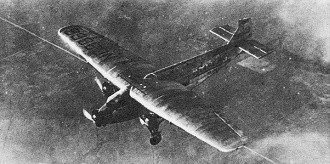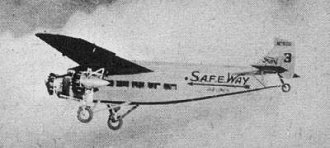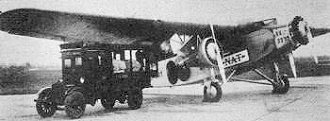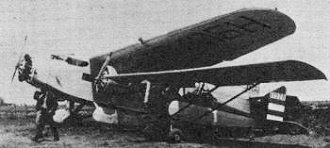I had no idea
that there were multiple versions of the Ford Trimotor (aka Tin Goose). This article from an 1962
edition of American Modeler magazine provides a fairly in-depth look at the history of the
airplane. If you follow politics at all, you know that
Halliburton is a name that
became a household word when George Bush chose Dick Cheney as his vice president.
According to author Joe Christy,
SAFE-way airline, which operated Ford Trimotors, was started by
Oklahoma oilman Erle Halliburton, and was sold to TWA (Trans World Airline) in 1931.
In an incredible stroke of good fortune, Melanie and I were able to take a ride
in a Ford Trimotor in the summer of 2013, flying out of Erie International Airport
(see my Ford Trimotor
video).Tin Goose - She Led the Golden Age

Southwest Air Fast Express' Ford was 25th 5-AT built; #9666 flew
between Missouri and Texas according to Burrell Tibbs, pioneer pilot, who supplied
1929 photos.
Story by Joe Christy
Commercial aviation in the U.S. owes its beginning to a very improbable letter.
Copies of it were mailed to a hundred Detroit businessmen by William Bushnell Stout.
It asked each for one thousand dollars. Stout said that he needed capital to build
a new kind of plane - and concluded with the unsettling statement that no contributor
should ever expect to see his money again. Twenty-five prospects promptly sent checks.
The letter was characteristic of young Stout, a mechanical engineer of unbounded
enthusiasm, the results were in tune with the country's 1923 mood. In the world
of finance, ceiling and visibility were unlimited. Henry Ford sold more than 1 1/2
million Model T's that year. Some businessmen were convinced because of the Post
Office Department's successful experiment with airmail that airplanes might offer
practical commercial value.

SAFE-way airline, started by Oklahoma oilman Erle Halliburton,
was sold to TWA in 1931.
Up until this time, there had been almost no attempt to put airplanes to work.
The single exception had been the barnstormers who daily risked their lives (and
those of their venturesome passengers) flying war surplus "Jennies" out of the nation's
cow pastures.
Two or three efforts had been made to establish an "airline." As early as 1914,
a 22-mile route, connecting St. Petersburg and Tampa, was flown for several weeks.
But the single passenger "airliner" failed to attract enough business to fill even
its one drafty seat. Another short-lived venture, spurred by Prohibition, was a
route between Key West and Havana, inaugurated early in 1923. But however thirsty
Americans may have been, they weren't that thirty. After all, ninety miles over
open water, in a wood-and-wire biplane, was carrying the habit a little too far.
The "new kind of plane" in which Stout asked the Detroit industrialists to invest
was a small three-place monoplane conventional in every way except one - it was
built from and covered entirely with metal. This was revolutionary in the United
States, though Junkers, a German aircraft firm, had built such craft during WW-I.
Stout's plane was powered (or, more accurately, underpowered) with a 90-hp OX-5
engine (obtainable as war surplus for $50 each).
Bill called this craft the Stout Air Sedan. Only one was built. Although few
people heard of it, it was one of the most successful airplanes ever conceived.
True, its performance was less than sensational. In fact, it barely flew. But it
succeeded fabulously in another way ... it interested Edsel Ford.
When Edsel came by for a visit, Bill explained the need for more horsepower -and,
of course, more money. Edsel went to his father. Within a few months the mighty
Ford Motor Company had built an airplane factory and an airfield and "leased" them
to the Stout Metal Plane Company.
Deliriously happy, Bill designed and built two planes during 1924. He called
them the Model 2-AT ("AT" hopefully stood for Air Transport). These 2-AT's were
essentially 8-passenger versions of his first plane. Larger aircraft had full cantilever
wings, they had no external bracing-a very advanced concept in 1924. They were all-metal,
covered with corrugated aluminum, powered with 400-hp Liberty engines. Although
water-cooled, heavy, and bulky the Liberty was one of the best airplane engines
of its day.
These two craft were ready when, early in 1925, Congress passed the Kelly Bill,
authorizing the Post Office Department to contract for air mail service with private
operators. And it seems likely, in retrospect, that this pending legislation may
have been what Henry Ford was thinking of when he financed Bill Stout.
Mr. Ford asked Bill if the Model 2-AT's were capable of dependable airline service.
Bill replied that that was what Mr. Ford had been betting his money on. Mr. Ford
said "Fine!" they'd begin a regular schedule between Detroit and Chicago right away.
He meant "right away," too. The first U.S. air freight line was in operation less
than a week later on April 13, 1925. Then, as quickly as a couple more 2-AT's could
be completed (eleven were built), the line also flew regularly scheduled flights
between Detroit and Cleveland.
The 2-AT's vindicated Bill's ideas about all-metal airplanes. Their rugged construction,
okayed by Bill's chief engineer George H. Prudden, who had been trained as a specialist
in reinforced concrete structures, proved exceptionally trouble-free maintenance-wise.
The 2-AT's never injured a passenger during their service on the Ford airlines.

Eleventh Goose off production line, NC-1780 was registered
to Marcell N. Rand,
Graybar Bldg, New York City - currently A.M. HQ! (Ford pix).
In July 1925 the Ford Motor Company "purchased" the Stout Metal Plane Company.
The twenty-five original investors, who had been warned never to expect to see their
money again, received back double their investment. Bill and his employees remained
to work in Ford's Aviation Division.
Now Henry Ford was officially in the airplane business. Characteristically he
gave it the same all-out effort that marked his participation in the automobile
business. He began carrying passengers on his freight lines. He built the first
concrete runways in the U.S., the first airport control tower, the first air hotel,
pioneered in air-to-ground radio communications, spent huge sums to advertise air
travel to the American public. Just as important, Ford's mere presence in aviation
gave the infant industry tremendous prestige and helped to attract other needed
capital. Henry Ford was regarded as a financial wizard, if he thought flying had
a future, it was a thing worth looking into.
In October, the Postmaster General awarded airmail contracts to each of the routes
operated by the Ford Air Transport Company. In February 1926 the Ford airline became
the first to carry the nation's mail.
Meanwhile, at Henry Ford's direction, Bill and his engineers came up with the
first Ford Trimotor. A trimotor design, long cherished by plane builders, had suddenly
become possible with the introduction of the new Wright "Whirlwind" air-cooled engine.
But the first trimotor was something of a freak.

Daddy of famed Trimotors was single engine 2-AT "Maiden Dearborn
IV", operated by Ford Air Transport Co., first airline to fly nation's mail.

Ford's Model 3-AT was initial 3-motored venture by auto outfit.
Short lived, performance matched its appearance.

National Air Transport Tin Goose loads mail. N.A.T., plus Varney
Air Lines, Pacific Air Transport, and Boeing Air Transport, became United Air Lines.

Home-built tucked under Goose's wing had Model A Ford engine
(note '30 Ford radiator shell). This Trimotor flew first as S.A.F.E. transport,
later bore American Airlines markings.
Labeled Model 3-AT, it looked as if it had been designed by the office scrub
woman - with an assist from an intoxicated Zeppelin commander. Vaguely it resembled
an enlarged 2-AT, with a pair of Wright "Whirlwinds" hurriedly affixed to the leading-edges
of the wings. The nose section, tall enough for passengers to stand in, with observation
windows all around, featured a third engine on its "chin." The pilots' cockpit which
appeared to be an after-thought was between the engines on top of the wing, and
not enclosed. It turned out that the 3-AT's performance pretty much matched its
looks. Test pilots reported that she "cruised at 85, landed at 85, and had a top
speed of 85." Fortunately, it was destroyed in a hangar fire after 3 hops.
It is not recorded what Mr. Ford had to say about the 3-AT fiasco, but even Henry's
enemies would admit that he didn't give up easily. Bill and his engineers began
work on another trimotor - and went from one extreme to the other. This one was
a classic in the full sense of the word!
Designed and built in slightly over four months, it emerged for its first flight
on June 11, 1926. Officially Model 4-AT, it was soon dubbed affectionately, "Tin
Goose," by those who flew her. Goose or not, she ushered in aviation's Golden Age.
In many ways, the Tin Goose has never been equaled in performance. She would
take off, fully loaded, in less than 900 feet-and "fully loaded" meant all that
could be crammed inside. Her flight characteristics were such that one pilot, Harold
Johnson, repeatedly pulled her into a loop as her wheels broke ground on take-off.
At least once, he performed this maneuver with the nose-engine inoperative. There
wasn't a fighter plane in the world at that time that could do it - and the Goose
was a six-ton airliner!
First 4-AT's off the production line were eight-passenger models, but the plane
was soon enlarged to carry twelve (eventually, fifteen). The earlier ones, with
200-hp Whirlwinds, cruised at 95-mph and had a top speed of 115. It wasn't that
the Goose was slow, it was just that she had her own gait. She'd do anything anyone
asked of her, but she didn't like to be hurried. Bigger engines helped a little,
though not much. Equipped with 300-hp Wright engines and 420-hp Pratt and Whitney
Wasps, her cruising speed went up to 115 and 122, respectively.
The Goose sold for $42,000. She had a wingspan of 77 feet and was 50 feet long.
Pilots were agreed that she could not be overloaded. What you could get inside,
she'd get into the air. And empty or fully loaded she handled the same - asking
favors of no one. She was built like a bridge; structural failure in flight was
a physical impossibility.
Thus it was that all the ingredients necessary for profitable commercial flying
finally came together in a safe and efficient plane. Guaranteed payments for carrying
the mail resulted in the attraction of new capital.
Airlines, equipped with the fabulous Goose, blossomed out all over the nation.
Then came a tremendous boost. In May 1927 Charles Lindbergh's flight to Paris caught
the public fancy. A huge passenger business was suddenly added to the new airlines'
bread-and-butter airmail revenue. By 1929, there were 14,000 miles of lighted airways
and 1,000 airports in the United States.
And what of the Goose? Admiral Byrd flew one over the South Pole. A fleet of
them operated by TAT Airline (now TWA) began the first transcontinental service.
Lindbergh (soon a TAT official) demonstrated the possibilities of high-altitude
air routes in a Goose. And when in May 1930 pretty, young Ellen Church was hired
by United Air Lines as the first air hostess, aviation's Golden Age was indeed in
full bloom.
Altogether, 199 Ford Trimotors were built before production ceased in 1932. The
airline market had been saturated, the country was near the low point of its Great
Depression. By the time economic conditions improved, a bigger and faster plane
was available to the airlines. Called DC-3, it, too, was a pretty good job.
Between twelve and fifteen Tin Geese are still licensed and flying (Admiral Byrd's
Goose is in the Ford Museum at Dearborn, Michigan). None ever wore out. Those that
are gone were flown into a cloud-full-of-rocks, or ran out of gas over rough country,
or were disposed of in some manner reflecting human-failure, rather than Goose-failure.
In fact, the Goose's unmatched abilities probably contributed to the destruction
of many. Because of her willingness to lift heavy loads in and out of small, rough
fields, she has been greatly prized by Latin-American bush pilots. Over the years,
in the world's remote places, unwise pilots asked things of her no airplane could
or should do.
Two are still in service in the United States. Operated by Island Air Lines out
of Port Clinton, Ohio, they fly a daily schedule, as they have been doing for 25
years, between Post Clinton, Put-in-Bay, Kelleys Island, North Bass, Middle Bass,
and Rattlesnake Islands. This adds up to an incredible 9,000 landings or take-offs
yearly. Island Air Lines has never had a fatality. Company officials say that they
have no idea how many engines their two Geese have worn out. This line is unique
in another way ... it is the only airline in the country to have a contract" with
a school board. During the school year, a Goose makes like a school bus twice a
day for kids living on Lake Erie islands.
Five Geese in the Northwest serve in reforestration, forest fire control, and
as general freight haulers. Others are scattered about the United States and Latin
America.
A few may be flying overseas. A number were sold to China, the Netherlands, Australia,
Czechoslovakia, Romania and Spain. There have been reports of one in Russia. One
is known to have helped in the rescue of British soldiers at Dunkirk. One was destroyed
by enemy fighter planes while evacuating wounded from Bataan, another met a like
fate in the Philippines.
But all this does not mean that the Goose will soon be extinct. Although Bill
Stout is gone, a West Coast company has been preparing to put the venerable old
craft into production again. Henry Ford II generously supplied to Hayden Aircraft
Corporation of Gardena, California, all original blueprints and design data of the
plane. Hayden plans to make the same old Goose.
A preliminary market study, conducted in Australia, Canada, and Alaska, indicated
more than a hundred orders for the plane; biggest market is expected to be Latin
America. The young men at Hayden Aircraft speak of an overall production potential
of 1,000 airplanes.
Hayden plans some minor changes to the original, things dictated by the Goose's
years of flight experience. The new Ford trimotor will be equipped with 450-hp Pratt
and Whitney R-985 engines. She will have a prettier rudder (we're a'gin it!), modem
instrument panel, Oleo shocks. A wide cargo opening, switched to the left side of
the fuselage, will replace the original passenger door.
The prototype tested at Santa Ana Airport met all F.A.A. requirements. The test
model gets off the ground easily in 850 feet, fully loaded; her top speed is in
excess of 150 mph. Rate-of-climb is over 1,000 feet per minute. Lloyd Saunders,
an official of the company, says that they are going to call it the Stout Bushmaster.
We imagine it will still be known as the Tin Goose.
Posted September 16, 2024
(updated from original
post on 1/4/2014)
|